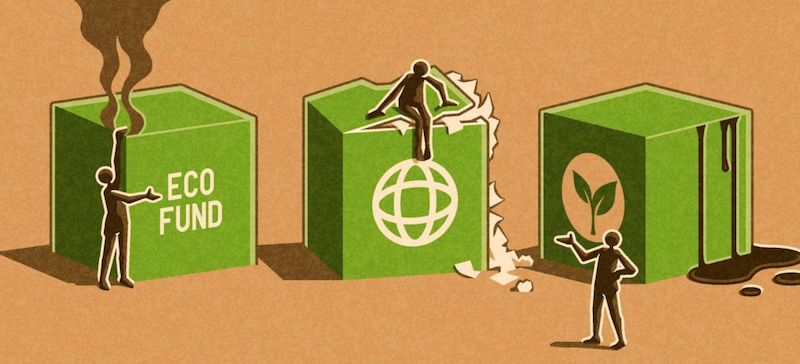Don’t let your company’s false claims about being environmentally friendly damage customers’ trust. This is called greenwashing and it hurts your company’s reputation.

You can design your ideal packaging here online: Pacdora
What is Greenwashing nowadays then?
Greenwashing is when a company uses environmental marketing to create an impression that their products, services, or policies are environmentally friendly when they aren’t. Greenwashing can be unintentional. Companies might have good intentions but not be knowledgeable about what they need to do to make sustainable claims. As a result of greenwashing, American consumers are skeptical of companies’ sustainability practices.
Greenwashing is a deceptive marketing tactic used by organizations to make consumers believe that they are more environmentally friendly than they actually are. This is done by investing more time and money into marketing themselves as such, instead of taking measures to actually minimize their environmental impact. It preys on the trust of people who want to support brands that are conscious of the planet. Greenwashing is unethical and ruins the reputation of companies who engage in it, as well as those who fall victim to it.
Greenwashing redefined

You can design your ideal packaging here online: Pacdora
Jay Westerveld first coined the term “greenwashing” back in 1986, in an essay that was inspired by the irony of the “save the towel” movement in hotels. This movement didn’t have much of an impact beyond saving hotels money on laundry costs. The idea of greenwashing emerged during a time when most people got their news from television, radio, and print media. This meant that people couldn’t fact-check the way they can today.
With the rise of social media, consumers now have a platform to voice their opinion and share news stories with a much wider audience. This has led to greater transparency and accountability when it comes to greenwashing claims made by companies.
Companies that have engaged in greenwashing have made headlines over the years. In the mid-’80s, oil company Chevron commissioned a series of expensive television and print ads to broadcast its environmental dedication. But while the now-infamous “People Do” campaign ran, Chevron was actively violating the Clean Air Act and Clean Water Act, as well as spilling oil into wildlife refuges.
However, greenwashing today can have a positive impact over its brand as companies are subconsciously becoming more green. Companies want to show that they are sustainable and responsible, so they are increasingly engaged in greenwashing. While some greenwashing is still misleading and deceptive, overall it is having a positive impact by increasing awareness and action on environmental issues.
How greenwashing hurts a brand’s reputation in the old days

You can design your ideal packaging here online: Pacdora
Greenwashing has changed a lot over the last 20 years, but it’s still definitely something that happens. With more and more people wanting to be environmentally friendly, companies face an increased risk of being sued for making false claims about how environmentally friendly their products or practices are.
The Alliance to End Plastic Waste (AEPW) is a Singapore-based nonprofit that is funded by some of the world’s biggest oil and chemical companies, such as Shell, ExxonMobil, and Dow. AEPW claims to be spending $1.5 billion to clean up plastic waste in developing countries. However, not only did the AEPW fail to honor its promise to clean up the Ganges River in India, but its member organizations also went ahead with plans to produce even more plastic. AEPW had to pour some money to improve the plastic issues. While this may seem like a negative outcome, it actually highlights the power of greenwashing. By publicly committing to reduce plastic waste, AEPW attracted a lot of positive attention. This in turn put pressure on the company to actually follow through on its promises. As a result, AEPW was forced to invest in improving its plastic waste management. In the end, greenwashing helped the company to become more sustainable.
The bottled water industry is not the only one guilty of overselling their “greenness.” Have you ever noticed how many plastic bottles have images of mountains, lakes, and wildlife printed on their labels? Beere, vice president of marketing at Sightline Payments said that while the core theme has stayed the same, the number one violation is embellishing the benefits of the product or service. He believes that greenwashing is rarely caused by malicious plots to deceive, but is more often the result of overenthusiasm.
It’s easy to see why marketers are enthusiastic about sustainability: according to GreenPrint’s 2021 Business of Sustainability Index, 64% of Gen X consumers would spend more on a product if it comes from a sustainable brand, and that figure jumps to 75% among millennials.
This shows that there is a huge potential market for sustainable products, and that consumers are increasingly interested in buying from brands that are doing their part to protect the environment. This is a great opportunity for businesses to tap into, and with sustainability becoming more and more important to consumers, it’s only going to grow in the future.
Greenwashing’s effect on consumerism

Greenwashing can have a domino effect on the way consumers act and behave. In an attempt to avoid being tricked by greenwashed products, consumers may actively look for eco-friendly products instead. However, this may lead them to finding a product that’s not greenwashed, but not the most sustainable/ethical option either. It’s important for companies to be honest in their marketing and avoid greenwashing so as not to cause confusion or mislead consumers.
Greenwashing vs green marketing
There are multiple brands that claim to be environmentally friendly, but how can you know for sure? Look for industry-recognized certificates and government-backed standards that support a company’s claims. Furthermore, greenwashing companies are often not open and transparent about the way they operate. So what’s the difference between greenwashing and green marketing? Green marketing is the process of marketing products based on their environmental benefits.
There is a significant difference between green marketing and greenwashing. Greenwashing is when companies illegitimately market their products or services as being environmentally friendly. Green marketing is when companies sell products or services based on actual environmental positives.
Generally, green marketing is practical, honest, and transparent. This means that a product or service meets the following criteria:
It is sustainable
It does not contain any toxic materials or ozone-depleting substances
It is recyclable or produced from recycled materials
It is made from renewable materials (such as bamboo)
How to avoid greenwashing
If consumer demand for sustainability is the frontier of our transition to a greener, fairer, and smarter global economy, here are some basic brand greenwashing tactics to avoid:
- Fluffy language: Be precise with your words and don’t use ones that will be interpreted in different ways (e.g., “eco-friendly” or “natural”).
- Green products vs. dirty company: Make sure your company’s practices align with your green values to avoid any hypocrisies (e.g., efficient light bulbs made in a factory that pollutes rivers).
- Evocative pictures: Don’t use images as part of your branding that could give an unjustified green impression (e.g., flowers blooming from exhaust pipes).
There are plenty of businesses that are being socially responsible and telling their environmental stories to the world. However, there are also some businesses that aren’t being truthful about their product’s impact. This is known as greenwashing.
Beere describes the buzzwords commonly used to greenwash as a “slippery slope” and advises companies to educate their marketers on the ethics of green branding.
How to Tell Greenwashing Companies?
When making sustainability claims, it’s important to be clear and concise. Include details such as specific units of measurement (e.g. “70% organic cotton” rather than “made with organic cotton”) and verifiable endorsements and certification from credible third-party eco-organizations, such as the Sierra Club or Greenpeace.
Remember to back up your claims with data, and keep that data current. Include it on your website and anywhere else you make sustainability claims. Only use data that can be verified to avoid false advertising.
Make sure you’re comparing apples to apples when it comes to your product’s sustainability. If you want to make an environmentally friendly claim about your product, only compare it to other products of the same type so you’re not misleading consumers.
And remember, if you want to market your products as eco-friendly, you need to put your money where your mouth is by making sustainability part of your business model. This means implementing sustainable practices in your manufacturing, waste disposal and distribution operations.
It’s important to be honest with your consumers about your brand’s sustainability practices. Be clear about how green your individual products are, as well as your company’s overall sustainability practices. When discussing plans or goals, be specific about your targets and timelines so consumers can hold you accountable.
Make sure images on ads and packaging are not misleading. Don’t use the color green or images from nature, like trees and flowers, to imply that your products or brand are eco-friendly if that’s not the case.
Be careful with the following content
Clever marketers of large corporations know which words to use in order to appeal to their buyers – but these words hold no real substance or meaning. Be weary of terms such as “natural,” “organic,” “eco-friendly,” and “bio” – as they are oftentimes just buzzwords with no real value.
For example, did you know that some naturally-occurring substances like cyanide, arsenic, and asbestos can be deadly in trace amounts? Or that the term “organic” holds no weight unless the product is certified as such? When a product claims to be “eco-friendly,” ask yourself how exactly it is being friendly to the environment – is it made of recycled materials? Does it use less energy or water in its production than other similar products? If you’re not sure, do some research or ask the company for more information. In short, don’t be fooled by pretty words on a label – make sure you know what you’re really buying.
Transparency and corporate social responsibility
In an interview with Business News Daily, Deandra, former office manager for a sustainability organization that she requested go unnamed, stated that greenwashing is actually in a corporation’s best interest. Although the concept of corporate social responsibility exists, it is very rare that corporations actually live up to it. When they do make an attempt, it’s usually a surface-level effort to make themselves look good rather than a real concern for the environment. In other words, greenwashing benefits a corporation only when it successfully deceives its customers. Transparency can bridge the gap between artificial and genuine concern for the environment.
Outdoor clothing company Patagonia is a shining example of transparency in the business world. Unlike most companies, Patagonia doesn’t shy away from admitting its use of chemicals or the fact that it leaves a footprint. The company’s sustainability mission is described as a “struggle to become a responsible company,” and its website openly admits that Patagonia isn’t perfect when it comes to being environmentally responsible. But what separates Patagonia from other companies is its willingness to face its shortcomings and work towards improvement. This kind of transparency is something that more businesses should aspire to.
Do your best to tell your company’s sustainability story and avoid greenwashing. It’s a dirty practice, and we all know how costly it can be to clean up your image afterwards.

Leave a comment